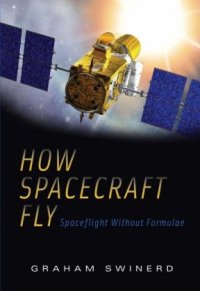
Ebook: How Spacecraft Fly: Spaceflight Without Formulae
Author: Graham Swinerd (auth.)
- Genre: Technique // Transportation: Aviation
- Tags: Astronomy, Popular Science in Astronomy, Aerospace Technology and Astronautics
- Year: 2009
- Publisher: Copernicus
- Edition: 1
- Language: English
- pdf
About half a century ago a small satellite, Sputnik 1, was launched. The satellite did very little other than to transmit a radio signal to announce its presence in orbit. However, this humble beginning heralded the dawn of the Space Age. Today literally thousands of robotic spacecraft have been launched, many of which have flown to far-flung regions of the Solar System carrying with them the human spirit of scientific discovery and exploration. Numerous other satellites have been launched in orbit around the Earth providing services that support our technological society on the ground.
How Spacecraft Fly: Spaceflight Without Formulae by Graham Swinerd focuses on how these spacecraft work. The book opens with a historical perspective of how we have come to understand our Solar System and the Universe. It then progresses through orbital flight, rocket science, the hostile environment within which spacecraft operate, and how they are designed. The concluding chapters give a glimpse of what the 21st century may hold in terms of human exploration of the Solar System and more futuristic propulsion technologies for interstellar travel.
Graham Swinerd invites you to understand "how spacecraft fly," while becoming a convincing rocket scientist along the way!
The aim of this popular science text is to explain aerodynamic and astrodynamic flight without the use of mathematics, in an informal style, for non-technical readers who are interested in spaceflight and spacecraft.The book will open with a concise introductory chapter, chronicling the ‘space age’ up to the present, and a brief ‘forward look’ into near-future developments. Chapter 2 provides the historical context upon which the current developments in spaceflight have been built. Orbital motion will be introduced in Chapter 3, and how to get there using launch vehicles is addressed in Chapter 4. Chapters 5 and 6 look at how spacecraft are designed, and Chapter 7 addresses the additional design constraints imposed if the spacecraft has a human crew on board. Chapter 8 gives examples of current and proposed spacecraft missions, both Earth orbiting and interplanetary. Chapter 9 will look at near future manned flight developments – for example, a mission to Mars and/or space tourism. The book closes with a concluding chapter, which reflects on prospects for the future of robotic and manned space exploration. __________Эта научно-популярная работа разъясняет принципы аэродинамического и астродинамического полёта простым языком без формул для несведущих в технике читателей, заинтересованных в космических полётах и аппаратах.